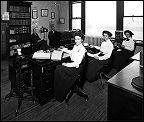| As we all strive to identify and play out our individual roles in this “world of work”, it is vital that we do so with a sense of balance and perspective.
Joseph Wood in his publication “Wealth and the Commonwealth”, said it well:
“It may seem for a moment that the world of labor is just a world of toiling units, each bearing the burden of its own life. But this is only a fragment of the truth. Our inventions, our just laws, our system of jurisprudence, our agricultural methods, all the things that contribute to the ease and safety of human life, have been won for us by the desperate struggle, ‘the agony and bloody sweat’ of a vast succession of obscure as well as illustrious ancestors. There would be no Wealth but for the Commonwealth.” [BA]
|
|
|
Making a Living
|
The history of labor is an ongoing story of efforts to serve self, family, community, and “public work”, or service to the “Commonwealth”. “Public work” means patterns of work that have public dimensions, work with public purposes, work by a public, work in public settings –as well as the “works” or products themselves. [BA]
|

Peder Ronning Farm, 1910
Windmill had a cable to transfer power
for pumping water from a nearby well.
Minnesota Historical Society

Western Freight Traffic Office, 1911
Women dressed in "career girl" costumes.
Photo by Hubbard, Minnesota Historical Society
|





